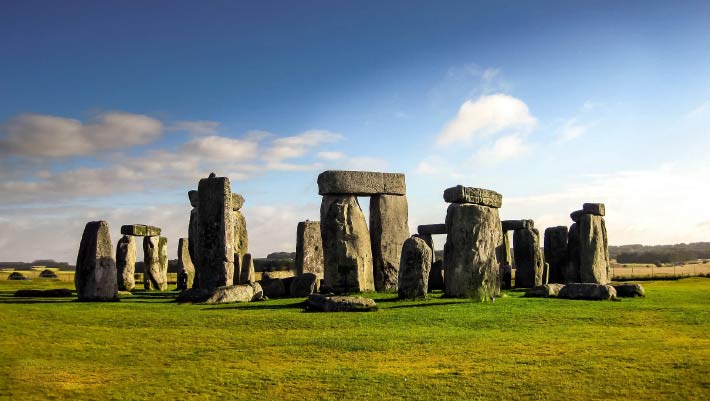Archaeologists from University College London and elsewhere have examined a molar tooth of a female Bos taurus (cow) discovered at Stonehenge.
Stonehenge. Image credit: Regina Wolfs.
In 1924, archaeologists recovered the right mandible of an elderly cow from the bottom of the ditch enclosing Stonehenge Stage 1, constructed in 2995-2900 BCE.
Using isotope analysis of one of its teeth, University College London’s Professor Michael Parker Pearson and his colleagues dated it to between 3350 and 2920 BCE and placed its likely origin in Wales.
“This is yet more fascinating evidence for Stonehenge’s link with south-west Wales, where its bluestones come from,” Professor Parker Pearson said.
“It raises the tantalizing possibility that cattle helped to haul the stones.”
The researchers sliced the cow’s third molar tooth, which records chemical signals from the animal’s second year of life, into nine horizontal sections.
They were then able to measure carbon, oxygen, strontium and lead isotopes, which each offer clues about the cow’s diet, environment and movement.
The different concentrations and varieties of elements embedded within the tooth provided insight into the cow’s life.
The oxygen isotopes revealed that the tooth captured roughly six months of growth, from winter to summer, whilst the carbon isotopes showed the animal’s diet changed with the seasons: woodland fodder in winter and open pasture in summer.
Additionally, the strontium isotopes indicated the seasonal food sources came from different geological areas, suggesting that the cow either moved seasonally or that winter fodder was imported.
The lead isotopes revealed composition spikes during the late winter to spring, pointing to a lead source that was older than the lead in the rest of the tooth.
The composition suggests the cow originated from an area with much older Paleozoic rocks, such as around the Preseli hills in Pembrokeshire, Wales, where the Stonehenge’s bluestones originated before being transported to Sailsbury Plain.
“This study has revealed unprecedented details of six months in a cow’s life, providing the first evidence of cattle movement from Wales as well as documenting dietary changes and life events that happened around 5,000 years ago,” said Professor Jane Evans, an archaeologist with the National Environmental Isotope Facility at the British Geological Survey.
“A slice of one cow tooth has told us an extraordinary tale and, as new scientific tools emerge, we hope there is still more to learn from her long journey.”
In addition, the scientists also concluded that the unusual lead signal could not be explained by local contamination or movement alone.
Instead, that lead stored in the cow’s bones had been remobilized during the stresses of pregnancy.
If true, this would mean the cow was female and pregnant or nursing during the tooth’s formation.
To test the hypothesis, the authors applied a peptide-based sex determination technique, which showed there was a high probability that the animal was female.
“This research has provided key new insights into the biography of this enigmatic cow whose remains were deposited in such an important location at a Stonehenge entrance,” said Cardiff University’s Professor Richard Madgwick.
“It provides unparalleled new detail on the distant origins of the animal and the arduous journey it was brought on.”
“So often grand narratives dominate research on major archaeological sites, but this detailed biographical approach on a single animal provides a brand-new facet to the story of Stonehenge.”
The team’s results were published on June 17, 2025 in the Journal of Archaeological Science.
_____
J. Evans et al. 2025. Sequential multi-isotope sampling through a Bos taurus tooth from Stonehenge, to assess comparative sources and incorporation times of strontium and lead. Journal of Archaeological Science 180: 106269; doi: 10.1016/j.jas.2025.106269
